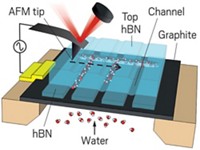Advertisement
Grab your lab coat. Let's get started
Welcome!
Welcome!
Create an account below to get 6 C&EN articles per month, receive newsletters and more - all free.
It seems this is your first time logging in online. Please enter the following information to continue.
As an ACS member you automatically get access to this site. All we need is few more details to create your reading experience.
Not you? Sign in with a different account.
Not you? Sign in with a different account.
ERROR 1
ERROR 1
ERROR 2
ERROR 2
ERROR 2
ERROR 2
ERROR 2
Password and Confirm password must match.
If you have an ACS member number, please enter it here so we can link this account to your membership. (optional)
ERROR 2
ACS values your privacy. By submitting your information, you are gaining access to C&EN and subscribing to our weekly newsletter. We use the information you provide to make your reading experience better, and we will never sell your data to third party members.
Environment
More On Hofmeister Ions
February 11, 2008
| A version of this story appeared in
Volume 86, Issue 6
The Science & Technology article about Hofmeister ions certainly spotlights the current interest in the properties of these ions in aqueous solutions and at aqueous interfaces (C&EN, Nov. 26, 2007, page 45). Hofmeister effects, however, are first and foremost thermodynamic effects-for example, on the surface tension of water, the aqueous solubility of hydrocarbons or proteins, and on protein folding (Acc. Chem. Res. 1969, 2, 257)—and many significant thermodynamic contributions were overlooked.
The origin of the effect lies in the preferential interactions (ions versus water) with the surface under consideration, which determine whether the local concentration of a Hofmeister ion in the water at a surface (molecular, biopolymer, or macroscopic) is greater than, less than, or equal to its bulk concentration (Biochemistry 1982, 21, 6545; Biophys. J. 1996, 71, 2056; and Adv. Protein Chem. 1998, 51, 281). There must be a difference between local and bulk salt concentrations for there to be an effect of a Hofmeister salt on the thermodynamics of a process involving a change in water-accessible (molecular, biopolymer, or macroscopic) surface area (ASA); the larger the difference between local and bulk concentrations, the larger the effect.
Effects of both Hofmeister salts and the corresponding spectrum of nonelectrolytes (osmolytes, denaturants) on all processes in aqueous solution accompanied by a change in ASA can be quantitatively interpreted or predicted using a surface (local)-bulk partitioning model (Biophys. J. 1995, 68, 786 and J. Phys. Chem. B 2007, 111, 5411), which neatly bridges the gap (highlighted in the article) between the results of physical chemists and the needs of the biochemical/biological community.
Laurel Pegram Tom Record
Madison, Wis.



Join the conversation
Contact the reporter
Submit a Letter to the Editor for publication
Engage with us on Twitter